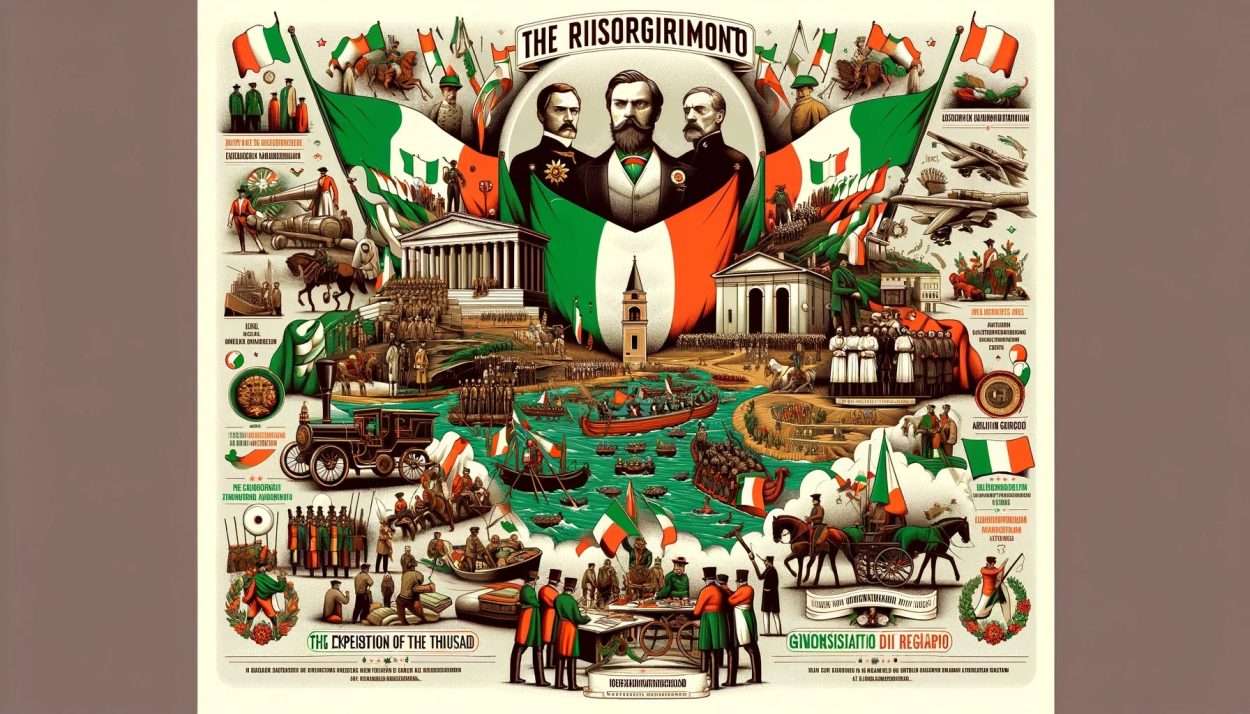
The Risorgimento: Detailed Exploration of Italy’s Unification Process

Class 10th, Subject Social Knowledge, Chapter 1 – Nationalism in Europe
Essay question –
Explain the process of unification of Italy?
The unification of Italy, known as the Risorgimento, was a complex and multifaceted process that took place during the 19th century. It involved a series of political, military, and diplomatic maneuvers that transformed a fragmented peninsula of separate states and kingdoms into the nation-state of Italy. The unification was marked by several key phases and figures, culminating in the establishment of the Kingdom of Italy in 1861. Here’s a detailed look at the process:
Background
Prior to unification, the Italian peninsula was divided into several states, including the Kingdom of Sardinia (Piedmont), the Kingdom of the Two Sicilies, the Papal States, the Grand Duchy of Tuscany, and the Austrian-controlled Lombardy-Venetia. The desire for a united Italy was driven by the principles of nationalism, which sought to bring together people with common linguistic, cultural, and historical backgrounds into a single nation.
Key Figures
- Giuseppe Mazzini: An early advocate for Italian unification, Mazzini founded the Young Italy movement in 1831, promoting the idea of a unified Italian republic. Though his early efforts were unsuccessful, he laid the ideological groundwork for the Risorgimento.
- Count Camillo di Cavour: The Prime Minister of Sardinia, Cavour was a pragmatic leader who used diplomacy and strategic alliances to achieve unification. He worked to expand Sardinian influence and set the stage for unification.
- Giuseppe Garibaldi: A revolutionary and military leader, Garibaldi was instrumental in unifying southern Italy. His conquest of Sicily and Naples with his Redshirts in 1860 was a pivotal moment in the unification process.
The Process of Unification
- The Second Italian War of Independence (1859): Initiated by Cavour’s diplomatic maneuvering, Sardinia allied with France against Austria in exchange for French support in expelling Austria from Lombardy and Venetia. The war resulted in the cession of Lombardy to Sardinia, although Venetia remained under Austrian control.
- Expedition of the Thousand (1860): Led by Garibaldi, this volunteer force landed in Sicily, quickly gaining control of the island and then marching on Naples. Garibaldi’s success rallied support for unification from the southern states.
- Annexation of Central Italian States: In the wake of Sardinia’s success against Austria and Garibaldi’s victories in the south, several central Italian states voted in plebiscites to join Sardinia.
- Formation of the Kingdom of Italy (1861): With the majority of the Italian peninsula under its control, the Kingdom of Sardinia was proclaimed the Kingdom of Italy in 1861, with Victor Emmanuel II as its first king.
- Acquisition of Venetia (1866) and Rome (1870): Venetia was acquired after the Austro-Prussian War when France, siding with Prussia, ceded Venetia to Italy. Rome remained under Papal control until 1870 when Italian troops took advantage of the withdrawal of French troops (who were defending the Papal States) to fight in the Franco-Prussian War. Rome was then annexed following a plebiscite, becoming the capital of Italy.
Conclusion
The unification of Italy was a landmark event in the history of nationalism, demonstrating the power of nationalistic ideals in reshaping the map of Europe. It was achieved through a combination of military conquests, popular support, and strategic diplomacy, overcoming significant obstacles to forge a unified Italian state. The process transformed the political landscape of the Italian peninsula and set the stage for Italy’s emergence as a unified nation on the world stage.